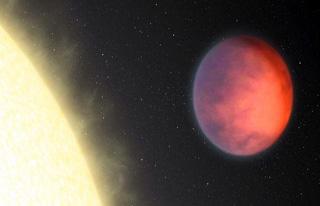
NASA's Spitzer Space Telescope has found that the hottest part of a distant planet, named upsilon Andromedae b, is not under the glare of its host star as might be expected. Photo: NASA/JPL-Caltech.
PASADENA, CALIFORNIA (BNS): Astronomers have recently unveiled a distant planet with a warm spot in the wrong place.
Observations made using NASA's Spitzer Space Telescope show the planet, named upsilon Andromeda b, orbits tightly around its star, with one side always facing the star's heat.
Astronomers, with the help of this infrared observatory, found that upsilon Andromedae b's hot spot is offset by a whopping 80 degrees. Basically, the hot spot is over to the side of the planet instead of directly under the glare of the sun.
"We really didn't expect to find a hot spot with such a large offset. It's clear that we understand even less about the atmospheric energetics of hot Jupiters than we thought we did," Ian Crossfield, lead author of a new paper about the discovery, was quoted as saying in a NASA news release.
The results are part of a growing field of exoplanet atmospheric science, pioneered by Spitzer in 2005. Since then, Spitzer, along with NASA's Hubble Space Telescope, has studied the atmospheres of several hot Jupiters, finding water, methane, carbon dioxide and carbon monoxide.
As per the new study, astronomers report observations of upsilon Andromedae b taken across five days in February of 2009. This planet whips around its star every 4.6 days, as measured using the "wobble," or radial velocity technique, with telescopes on the ground.
Spitzer measured the total combined light from the star and planet, as the planet orbited around. The telescope can't see the planet directly, but it can detect variations in the total infrared light from the system that arise as the hot side of the planet comes into Earth's field of view. The hottest part of the planet will give off the most infrared light, the release added.
The researchers aren't sure how the offset is possible, but theories include supersonic winds triggering shock waves that heat material up, and star-planet magnetic interactions.
But these are just speculation. As more hot Jupiters are examined, astronomers will test new theories.
 Previous Article
Previous Article Next Article
Next Article













The Indian Air Force, in its flight trials evaluation report submitted before the Defence Ministry l..
view articleAn insight into the Medium Multi-Role Combat Aircraft competition...
view articleSky enthusiasts can now spot the International Space Station (ISS) commanded by Indian-American astr..
view article